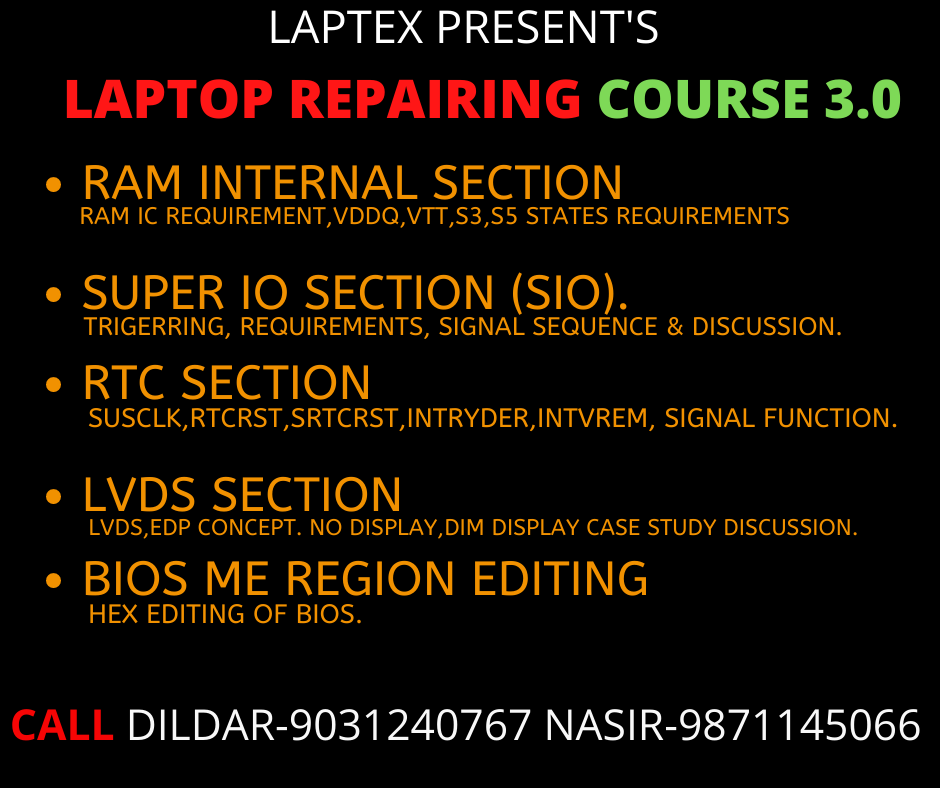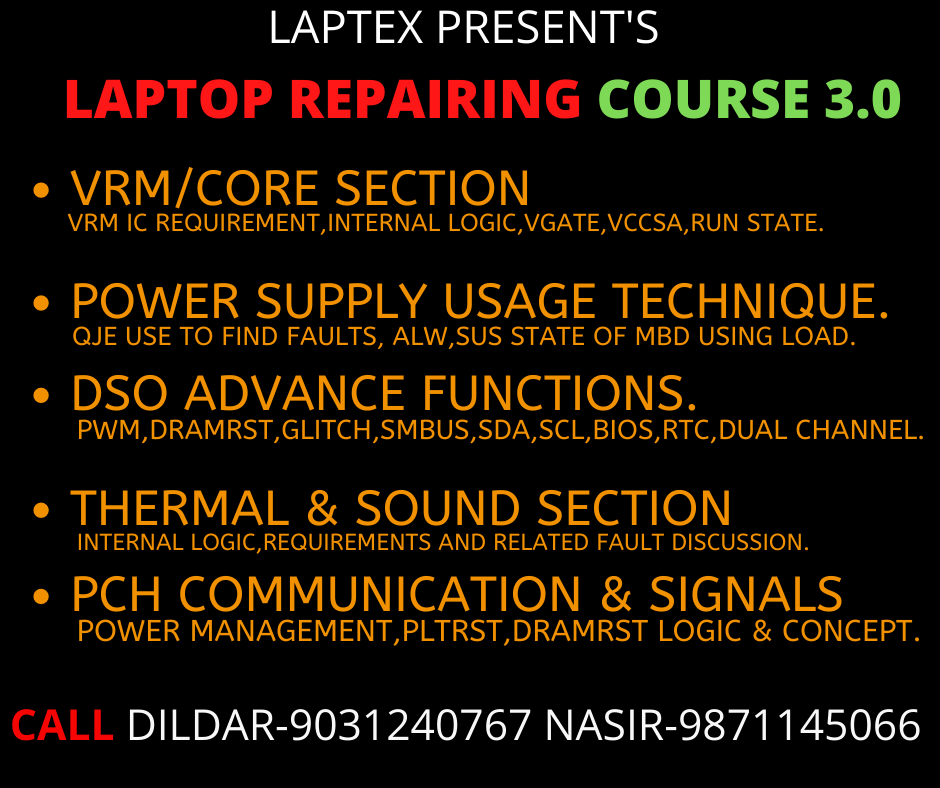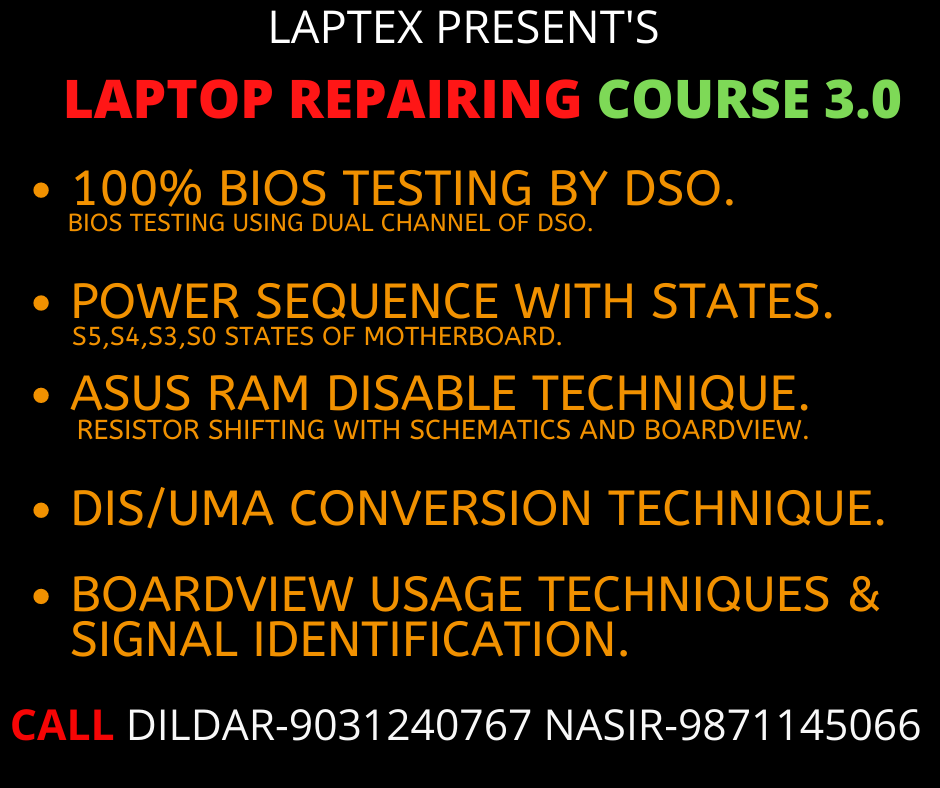BASIC ELECTRONICS COMPONENTS SWITCHING SECTION: Includes resistors, capacitors, an inductor or coil, a diode, a zener diode, a BJT, a MOSFET, an op-amp, and their applications. Application and testing of various components by the UNI-T DSO, Fluke Multimeter, QJE Power Supply, etc. How to check any faulty electronic components used in the laptop motherboard with different diagnosing methods Different applications, such as a Zener diode as a voltage regulator, an op-amp as a comparator or amplifier, a diode as a switching device, and a Schottky diode as a high-frequency switching device.
ADAPTER VOLTAGE 19V DCIN/VOLT-IN SECTION: This section contains various 19-volt sections on the laptop motherboard. Switching and blocking device or Mosfet combinations could be different, such as a single Mosfet for switching and a single Mosfet for blocking, both n- and p-channel, a dual mosfet, a diode and a mosfet, etc. The first step is to activate the GATE of the switching and blocking MOSFETs, which will switch the 19V from the adapter into the various sections of the laptop motherboard. Complete channel opening is important for the DCIN or VOLT-IN section mosfets to solve no power on or plug in not charging faults in the laptop motherboard.
3V/5V POWER SUPPLY STANDBY SECTION: The 3V/5V power supply section is one of the most important sections of the laptop motherboard. The PWM voltage generated by this section is supplied to different sections of the motherboard, like the RTC section, LID switch, SDA, SCL, power button, battery connector, SIO, etc. This is the starting supply in the power-up sequence of the laptop motherboard. Commonly used ICs are TPS51125, TPS511225, Richtek RT8205, and RT8243. Internal Logic & Concept with different faults is discussed with troubleshooting in the complete course.
CHARGING SECTION AND BATTERY CHARGER REQUIREMENTS - The charging section is one of the most conceptual and logical sections of the laptop motherboard.There are two functions of the battery charger IC: the first is to switch the DCIN section, i.e., the 19V in the motherboard, and the second function is the well-understood function of charging the battery. Important signals of the laptop motherboard charging IC are DCIN, ACIN, ACDET, ACOK, ACOK#, REGN, BTST, SDA, SCL, LDO, ILIM, etc. Common laptop battery charger ICs used are BQ24745, BQ24727, BQ24725, BQ24735, BQ24737, BQ24780, BQ24725A, BQ24781, BQ25700, BQ24790, and BQ24792, as well as the latest generation C-Type charger IC concept and fault case study discussion, etc.
Practical Cold Testing of a Laptop Motherboard with a Multimeter and a Power Supply: Impedance value testing with a multimeter of various sections of a laptop motherboard Different sections have different values of impedance, like the CPU core section, DCIN section, RAM section, etc. The impedance value depends on the architecture of the motherboard. Laptop motherboard sections have a different impedance value for normal and unhealthy conditions, with a high value for a healthy condition and a low value in cases of faulty or shorted conditions. In the event of a faulty section of the laptop motherboard, the same section needs to be diagnosed or replaced with a new spare.
.png)
RAM (random access memory) POWER SUPPLY INTERNAL LOGIC SECTION: The RAM section power supply is very important. S3 state supply for establishing a communication gateway between the CPU and RAM module to enable all the necessary lines required in the channel of communication for S0 state and powering up the sequence and display on the screen. RAM IC Requirements, VDDQ, VTT, S3 States, S5 States: Supply Concept and Logic DDR1, DDR2, DDR3, DDR3L, DDR4, DDR5 etc.
SUPER IO CONTROLLER or EC EMBEDDED CONTROLLER SECTION (SIO): SIO working, SIO power supply requirements, SIO triggering logic, SIO signal sequence, and fault finding PCI Express section, Clocks, Flex Clocks, SM Bus, GPIO, Controller Link, I2C communication, DACs, Analog and Digital Supply, EC Chip Replacement Techniques, Chiplevel SIO Power Supply, Signal Testing and Fault Finding, and many more case studies are discussed in the complete online video course.
RTC SECTION: The Real Time Clock Section is a very important and critical section of the laptop motherboard, SIO, and PCH. 32.768 kHz generation, VCCRTC supply, RTC signals, and reset voltage such as RTCX1, RTCX2, RTCRST#, SRTCRST#, SUSCLK, INTVRMEN, and INTRUDER# concepts, logic, and fault findings with case studies are explained step-by-step in the course. This is a comprehensive and detailed analysis of all the sections concerned with the RTC section that causes no power or does not trigger faults in the laptop motherboard.
LVDS SECTION: LVDS, EDP concept for display on screen, LVDS and EDP faults and solutions. Laptop no display faults, dim display faults, display available on external port but no display on screen failure troubleshooting LVDS section signals such as PCH_ENVDD, EC_ENVDD, LCDVDD, EN_INVPWR, INV_PWR_SRC, DISPOFF#, MC_DATA, MC_CLK, LVDS_DDC_CLK, LVDS_DCC_DATA, CE_EN, DBC_EN, etc. No display faults related to various signals are explained with case studies.
BIOS (Basic Input Output System) Section: This section deals with the ME (Management Engine) region concept, BIOS update, BIOS editing, BIOS mods, HEX editing of the different regions of the BIOS using a HEX editor, and solving different faults in laptop motherboard repairing. Motherboard faults like slow laptop performance, slow boot-up, and hanging problems can be easily solved with BIOS editing and updates. A case study related to the BIOS problem is explained in the course.

VRM/CORE SECTION: Core IC Requirements, Internal Logic, VR_EN, VGATE, VCCSIO, VCCSA, ISUM, VCCSENSE, PROG, etc. Pins working with single and multi-phase regulator ICs CPU power supply is provided by the VRM/CORE section. No display faults and many other problems can be solved with a complete understanding of the VRM, CORE, or CPU supply section.
POWER SUPPLY TECHNIQUES: Power supply techniques are used to find faults such as the always and suspend modes of the laptop motherboard sequence. Laptop motherboard fault finding using the current injection method Different chiplevel faults can be troubleshooted using power supply techniques.
DSO/CRO/OSCILLOSCOPE ADVANCE SETTING, TRIGGER AND FUNCTION - Digital Storage Oscilloscope application to test signal and reset supplies. Pulse width modulation (PWM), GATE trigger, DRAMRST, Differential signal testing, RTC section frequency signal testing, EC_RST#, SMBus SDA, SCL communication etc.

Thermal and sound section: application, fault detection, and connection to various sections of the laptop motherboard. Sound section troubleshooting and related practical case studies.
PCH (PLATFORM CONTROL HUB) COMMUNICATION & SIGNALS - The power management section of PCH communicates with different sections such as the SIO section, BIOS section, CPU section, RAM section, VRM section, etc. The complete state and details of PCH are discussed in the chip-level laptop repair training course.
COMPLETE BIOS TESTING BY DSO: BIOS signals such as MISO, MOSI, CS#, CLK, and VCC are tested with DSO to find the exact reason and section related to laptop no-display faults, dim-display faults, late-display faults, etc. Signal testing using DSO helps find noise and glitches in the signal.
LAPTOP MOTHERBOARD POWER SEQUENCE WITH STATES - States such as S5, S4, S3, S0 and G3 states are discussed in the laptop repairing course.
ON-BOARD RAM DISABLE TECHNIQUE - Lenovo, Acer, Dell etc. On-board RAM disable is done with logic on schematics and boardview.

GRAPHICS TO NON-GRAPHICS CONVERSION LOGIC AND TECHNIQUE - Graphics problems can be solved with graphic to non-graphics conversion with the logic and concepts.
BOARDVIEW USAGE TECHNIQUES & SIGNAL IDENTIFICATION: Allegro and Tabo boardview software application for component finding and fault troubleshooting is covered in the laptop chiplevel repairing course.
SOC (SYSTEM ON CHIP) CPU (CENTRAL PROCESSING UNIT) SECTION & COMMUINICATION - CPU communication is covered in the laptop training course. CPU works in many states which is essential to find the actual fault and sectionalise the area responsible for the problem.
CSME REGION CLEANING, MODING and EDITING - CSME region, TXE region, ME region, RSA signature edting, cleaning and moding technique helps in solving laptop no display fault, laptop late display problem, laptop turning on and getting off, laptop turning off after fixed time etc.
PRACTICAL TOOLS USAGE & APPLICATION - Complete motherboard repairing practical case studies, techniques and tips with tools such as DSO, power supply, multimeter, bios programmer, SIO programmer, SVOD, ENIT, etc.

1. Complete Laptop Repairing Training With 300+ Videos.
2. FREE BIOS, Schematics & Guidance on Faults for Lifetime.
3. Master Online Live Query Class FREE with this Post Course.
CALL NOW - 9871145066, 9031240767
Disclaimer: We are not authorized service center of hp dell acer Lenovo and apple we only repair/sell out of warranty laptop and use 100% compatible parts.
All product names, logos, brands, trademarks and registered trademarks are property of their respective owners!!!